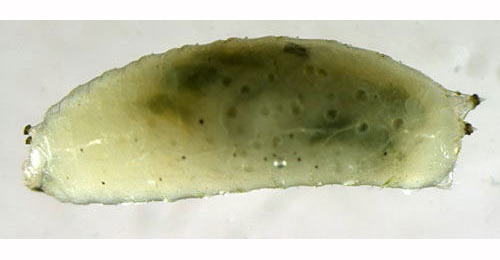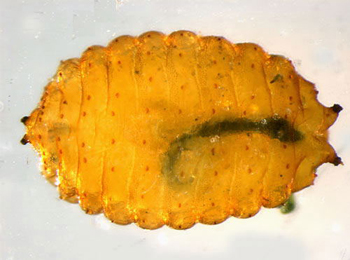|
||||||
| Aulagromyza
cornigera (Griffiths, 1973) [Diptera: Agromyzidae] |
||||||||||||||||||||||||||||||||||||||||||||||||||||||||||||||||||||||||||||||||||||||||||||||||||||||||||||||||||||||||||
|
Paraphytomyza
cornigera
Griffiths, 1973b. Entomologist's Gaz. 24(4): 307 |
||||||||||||||||||||||||||||||||||||||||||||||||||||||||||||||||||||||||||||||||||||||||||||||||||||||||||||||||||||||||||
|
Leaf-miner: A long white mine. Pupation external (Spencer, 1972b: 62 (fig. 209), 65, as lonicerae). Strongly widening, upper-surface, unbranched corridor; its first section usually follows the leaf margin for some distance. Pupation outside the mine; exit slit in upper epidermis (Bladmineerders van Europa). Leaf mine is formed in the young tender leaf. Larva forming long white mine which widens (British leafminers). Larva: The larvae of flies are leg-less maggots without a head capsule (see examples). They never have thoracic or abdominal legs. They do not have chewing mouthparts, although they do have a characteristic cephalo-pharyngeal skeleton (see examples), usually visible internally through the body wall. Posterior spiracles with a distinctive horn-like process within the ellipse of bulbs (Spencer, 1972b: 65, as lonicerae). The larvae are described Griffiths (1973), Dempewolf (2001: 166) and illustrated in Bladmineerders van Europa.
Puparium: The puparia of flies are formed within the hardened last larval skin or puparium and as a result sheaths enclosing head appendages, wings and legs are not visible externally (see examples). Posterior spiracles with a distinctive horn-like process within the ellipse of bulbs (Spencer, 1972b: 65, as lonicerae). The puparium is illustrated in Bladmineerders van Europa.
Hosts in Great Britain and Ireland:
Hosts elsewhere:
Time of year - mines: May-June. Time of year - adults: Currently unknown. Distribution in Great Britain and Ireland: Warwickshire (Exhall, Hartshill and Alvecote) (Robbins, 1991: 106-7) and Hampshire (Fleet) (British leafminers); East Norfolk, Glamorgan, Kintyre, Main Argyll, Merionethshire, Shropshire, and West Lancashire (NBN Atlas). Ireland National Biodiversity Data Centre Map). Distribution elsewhere: The Netherlands (Bladmineerders van Europa), Germany (Dempewolf, 2001: 166), French mainland, Poland and Spanish mainland (Fauna Europaea). NBN Atlas links to known host species:
British and Irish Parasitoids in Britain and elsewhere:
|
| Last updated 09-Jul-2019 Brian Pitkin | ||


